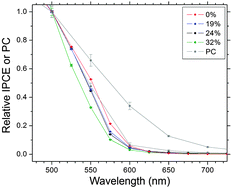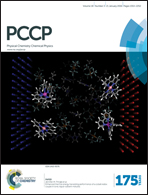Bandgap engineering of Fe2O3 with Cr – application to photoelectrochemical oxidation†
Abstract
Hematite is a promising material for photoelectrochemical (PEC) water splitting. While it has a low bandgap of ∼2.1 eV it is still larger than the optimal value of ∼1.8 eV. Previous work on epitaxial films has shown that Cr-doping leads to a shift of the bandgap as measured optically, but more importantly, also as measured by photoconductivity – to a value as low as 1.6 eV. We extend this work to polycrystalline films and attempt to use Cr-doping to lower the photon energy for which photocurrent can be generated. Our polycrystalline films show strong agreement with epitaxial films with regards to optical measurements of the direct and indirect bandgap. Furthermore, we find that Cr-doped polycrystalline films show photoconductivity at notably lower photon energies than undoped films, consistent with epitaxial results. However, when using Cr-doped films for photoelectrochemistry we find little to no shift of the photocurrent onset. We outline a number of proposals for why this could be the case, with a focus on the possibility of the existence of separate O 2p and Cr 3d states that would impact PEC but not PC behaviour.


 Please wait while we load your content...
Please wait while we load your content...